Information Technology: Management Role & Tourism Sector Advancements
VerifiedAdded on 2021/12/14
|10
|1577
|85
Report
AI Summary
This report provides a comprehensive overview of how information technology contributes to enhancing management quality and productivity, along with demonstrating the fundamentals of using computers for data storage, retrieval, presentation, and analysis. It delves into four key technology advancements in the tourism sector: IoT, AI, wearable devices, and VR, highlighting their impact on operational efficiencies and customer experiences. The report includes screenshots of a time management spreadsheet with a line graph and discusses the benefits of Microsoft Office applications, particularly Word, Excel, and PowerPoint, in academic settings. It elaborates on the features and functionalities of these applications, such as auto-correction in Word, chart recommendations in Excel, and collaboration features in PowerPoint, emphasizing their utility in data manipulation, visualization, and presentation. The paper concludes by underscoring the transformative effects of technology on the tourism industry and the adoption of VR, AI, wearable devices, and IoT to improve services and meet evolving customer expectations.
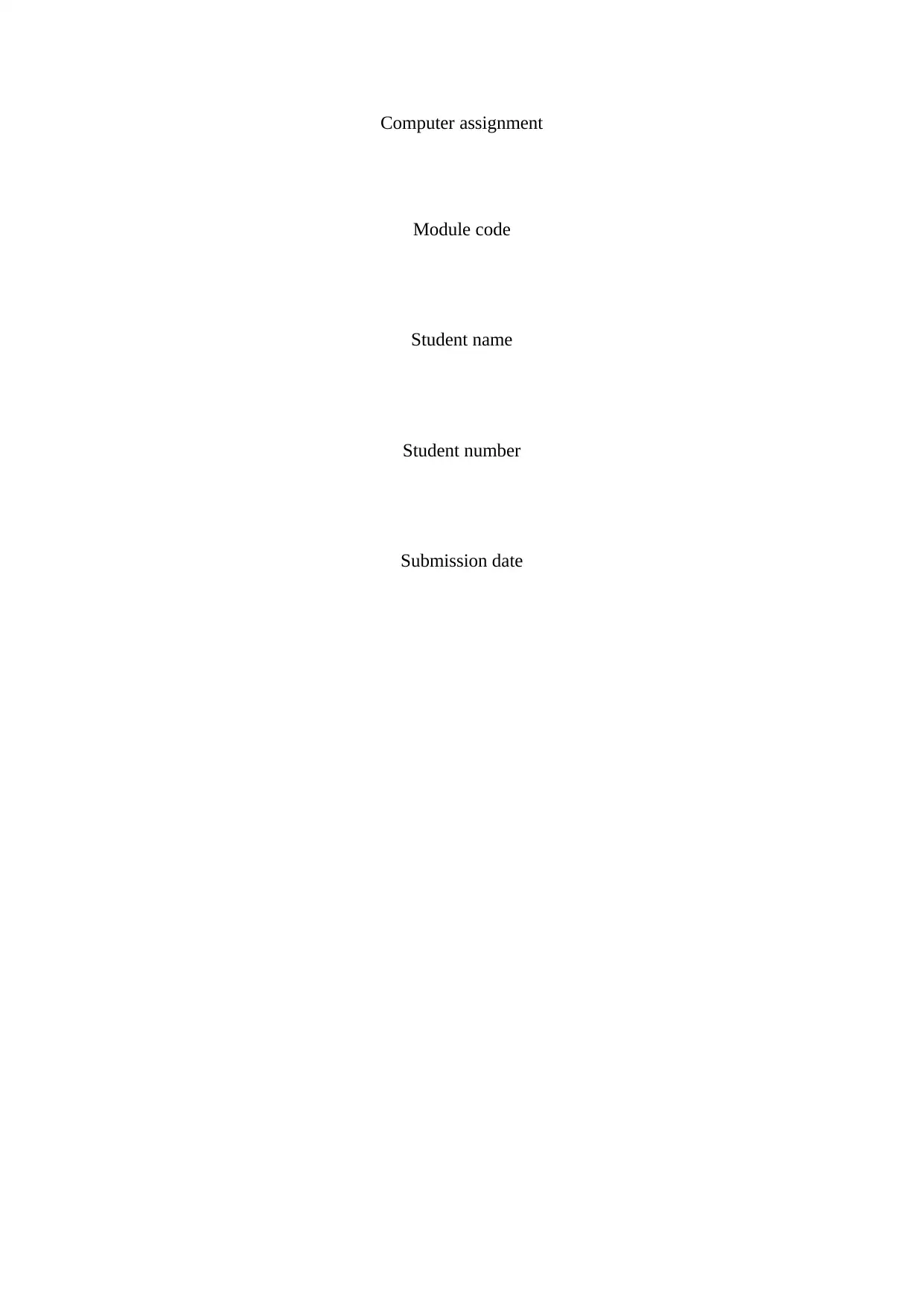
Computer assignment
Module code
Student name
Student number
Submission date
Module code
Student name
Student number
Submission date
Paraphrase This Document
Need a fresh take? Get an instant paraphrase of this document with our AI Paraphraser
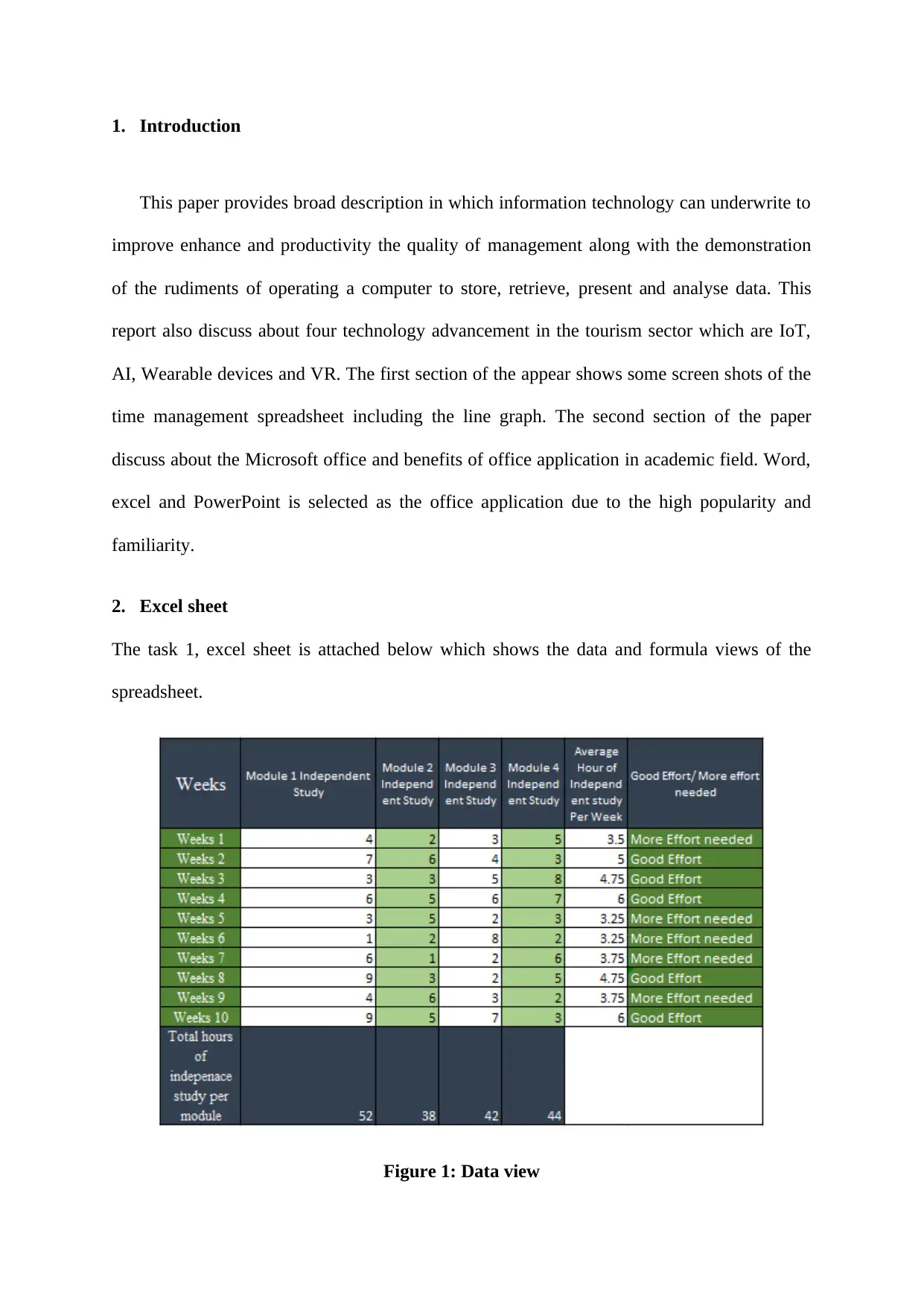
1. Introduction
This paper provides broad description in which information technology can underwrite to
improve enhance and productivity the quality of management along with the demonstration
of the rudiments of operating a computer to store, retrieve, present and analyse data. This
report also discuss about four technology advancement in the tourism sector which are IoT,
AI, Wearable devices and VR. The first section of the appear shows some screen shots of the
time management spreadsheet including the line graph. The second section of the paper
discuss about the Microsoft office and benefits of office application in academic field. Word,
excel and PowerPoint is selected as the office application due to the high popularity and
familiarity.
2. Excel sheet
The task 1, excel sheet is attached below which shows the data and formula views of the
spreadsheet.
Figure 1: Data view
This paper provides broad description in which information technology can underwrite to
improve enhance and productivity the quality of management along with the demonstration
of the rudiments of operating a computer to store, retrieve, present and analyse data. This
report also discuss about four technology advancement in the tourism sector which are IoT,
AI, Wearable devices and VR. The first section of the appear shows some screen shots of the
time management spreadsheet including the line graph. The second section of the paper
discuss about the Microsoft office and benefits of office application in academic field. Word,
excel and PowerPoint is selected as the office application due to the high popularity and
familiarity.
2. Excel sheet
The task 1, excel sheet is attached below which shows the data and formula views of the
spreadsheet.
Figure 1: Data view
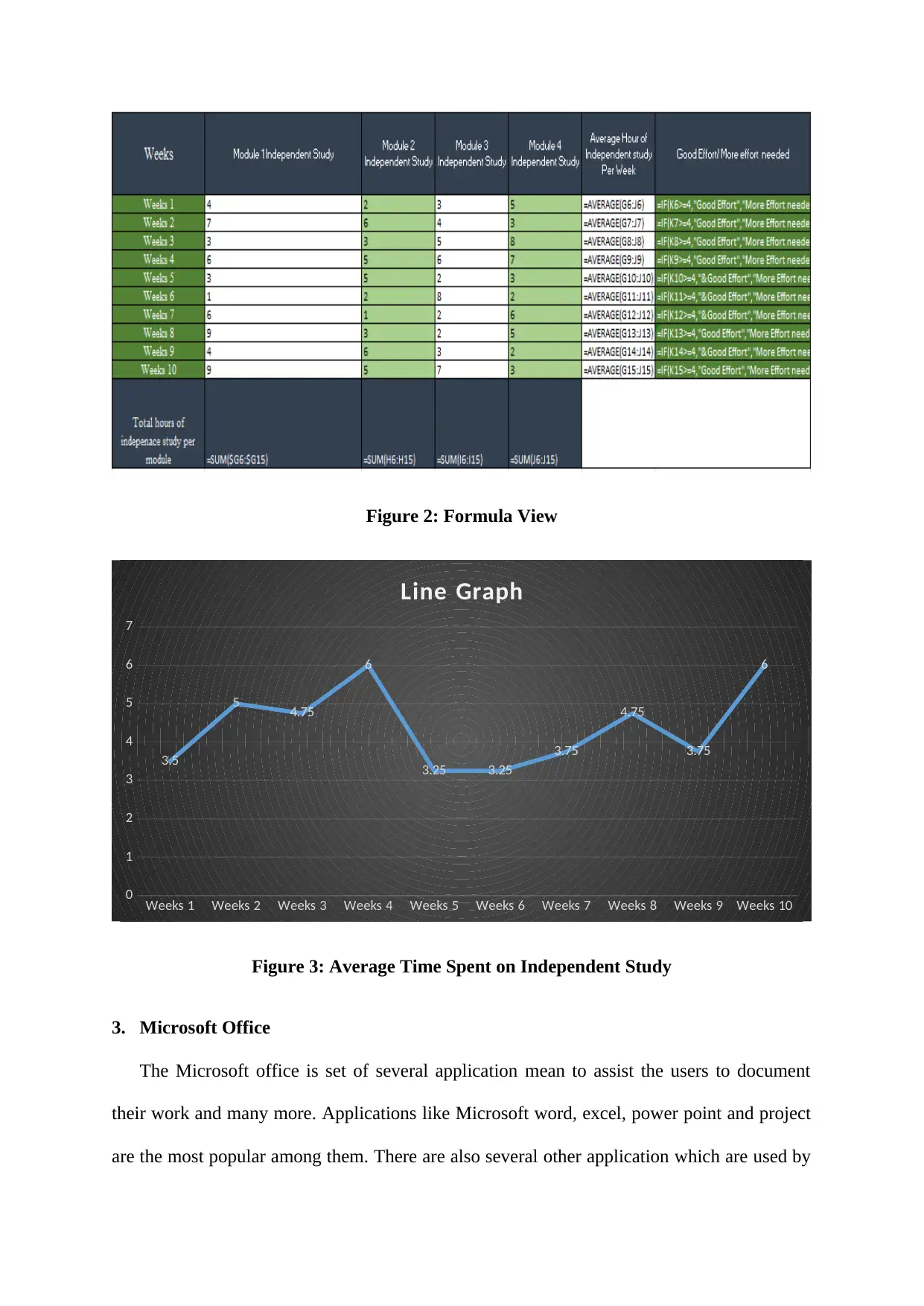
Figure 2: Formula View
Weeks 1 Weeks 2 Weeks 3 Weeks 4 Weeks 5 Weeks 6 Weeks 7 Weeks 8 Weeks 9 Weeks 10
0
1
2
3
4
5
6
7
3.5
5 4.75
6
3.25 3.25
3.75
4.75
3.75
6
Line Graph
Figure 3: Average Time Spent on Independent Study
3. Microsoft Office
The Microsoft office is set of several application mean to assist the users to document
their work and many more. Applications like Microsoft word, excel, power point and project
are the most popular among them. There are also several other application which are used by
Weeks 1 Weeks 2 Weeks 3 Weeks 4 Weeks 5 Weeks 6 Weeks 7 Weeks 8 Weeks 9 Weeks 10
0
1
2
3
4
5
6
7
3.5
5 4.75
6
3.25 3.25
3.75
4.75
3.75
6
Line Graph
Figure 3: Average Time Spent on Independent Study
3. Microsoft Office
The Microsoft office is set of several application mean to assist the users to document
their work and many more. Applications like Microsoft word, excel, power point and project
are the most popular among them. There are also several other application which are used by
⊘ This is a preview!⊘
Do you want full access?
Subscribe today to unlock all pages.

Trusted by 1+ million students worldwide
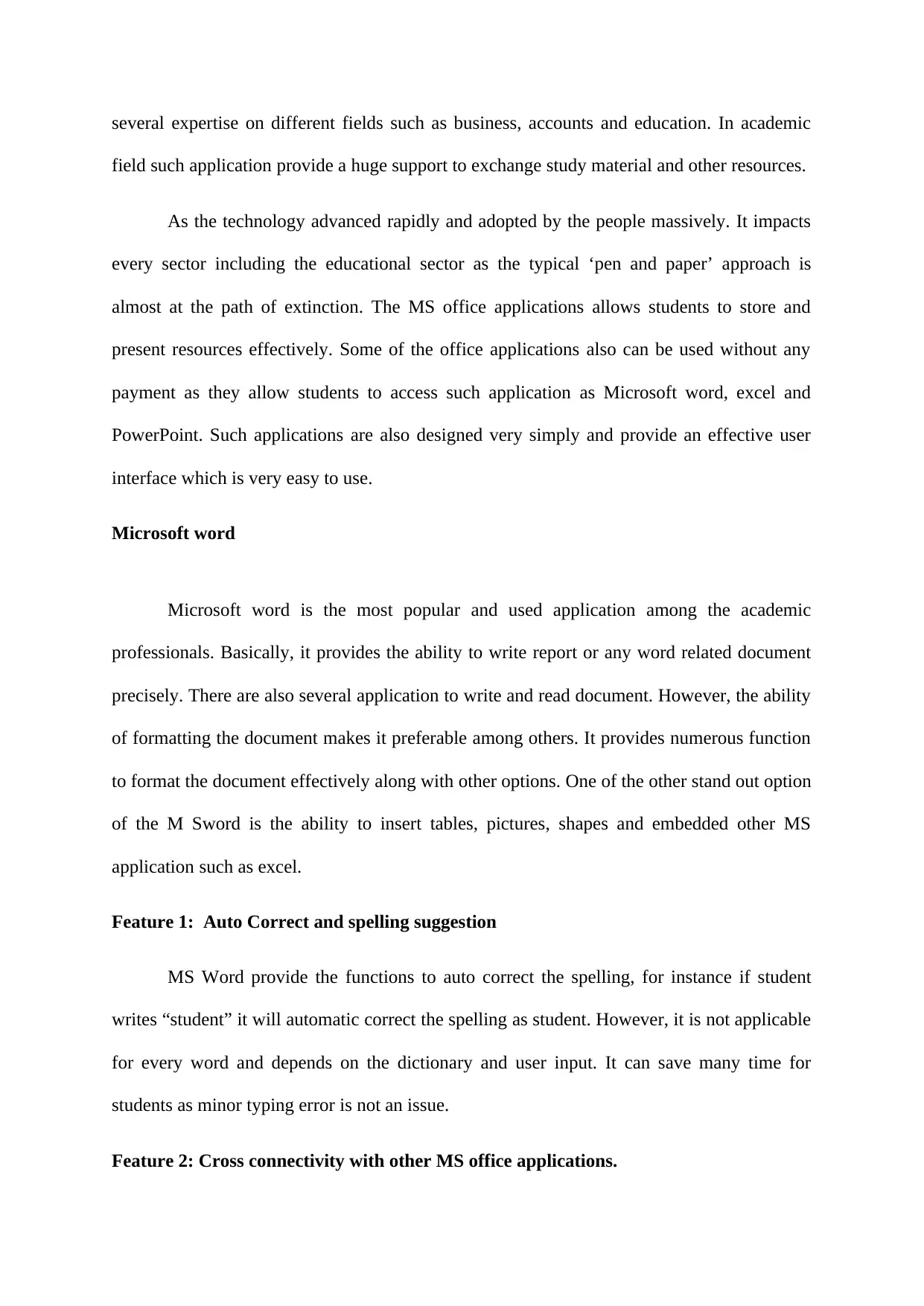
several expertise on different fields such as business, accounts and education. In academic
field such application provide a huge support to exchange study material and other resources.
As the technology advanced rapidly and adopted by the people massively. It impacts
every sector including the educational sector as the typical ‘pen and paper’ approach is
almost at the path of extinction. The MS office applications allows students to store and
present resources effectively. Some of the office applications also can be used without any
payment as they allow students to access such application as Microsoft word, excel and
PowerPoint. Such applications are also designed very simply and provide an effective user
interface which is very easy to use.
Microsoft word
Microsoft word is the most popular and used application among the academic
professionals. Basically, it provides the ability to write report or any word related document
precisely. There are also several application to write and read document. However, the ability
of formatting the document makes it preferable among others. It provides numerous function
to format the document effectively along with other options. One of the other stand out option
of the M Sword is the ability to insert tables, pictures, shapes and embedded other MS
application such as excel.
Feature 1: Auto Correct and spelling suggestion
MS Word provide the functions to auto correct the spelling, for instance if student
writes “student” it will automatic correct the spelling as student. However, it is not applicable
for every word and depends on the dictionary and user input. It can save many time for
students as minor typing error is not an issue.
Feature 2: Cross connectivity with other MS office applications.
field such application provide a huge support to exchange study material and other resources.
As the technology advanced rapidly and adopted by the people massively. It impacts
every sector including the educational sector as the typical ‘pen and paper’ approach is
almost at the path of extinction. The MS office applications allows students to store and
present resources effectively. Some of the office applications also can be used without any
payment as they allow students to access such application as Microsoft word, excel and
PowerPoint. Such applications are also designed very simply and provide an effective user
interface which is very easy to use.
Microsoft word
Microsoft word is the most popular and used application among the academic
professionals. Basically, it provides the ability to write report or any word related document
precisely. There are also several application to write and read document. However, the ability
of formatting the document makes it preferable among others. It provides numerous function
to format the document effectively along with other options. One of the other stand out option
of the M Sword is the ability to insert tables, pictures, shapes and embedded other MS
application such as excel.
Feature 1: Auto Correct and spelling suggestion
MS Word provide the functions to auto correct the spelling, for instance if student
writes “student” it will automatic correct the spelling as student. However, it is not applicable
for every word and depends on the dictionary and user input. It can save many time for
students as minor typing error is not an issue.
Feature 2: Cross connectivity with other MS office applications.
Paraphrase This Document
Need a fresh take? Get an instant paraphrase of this document with our AI Paraphraser
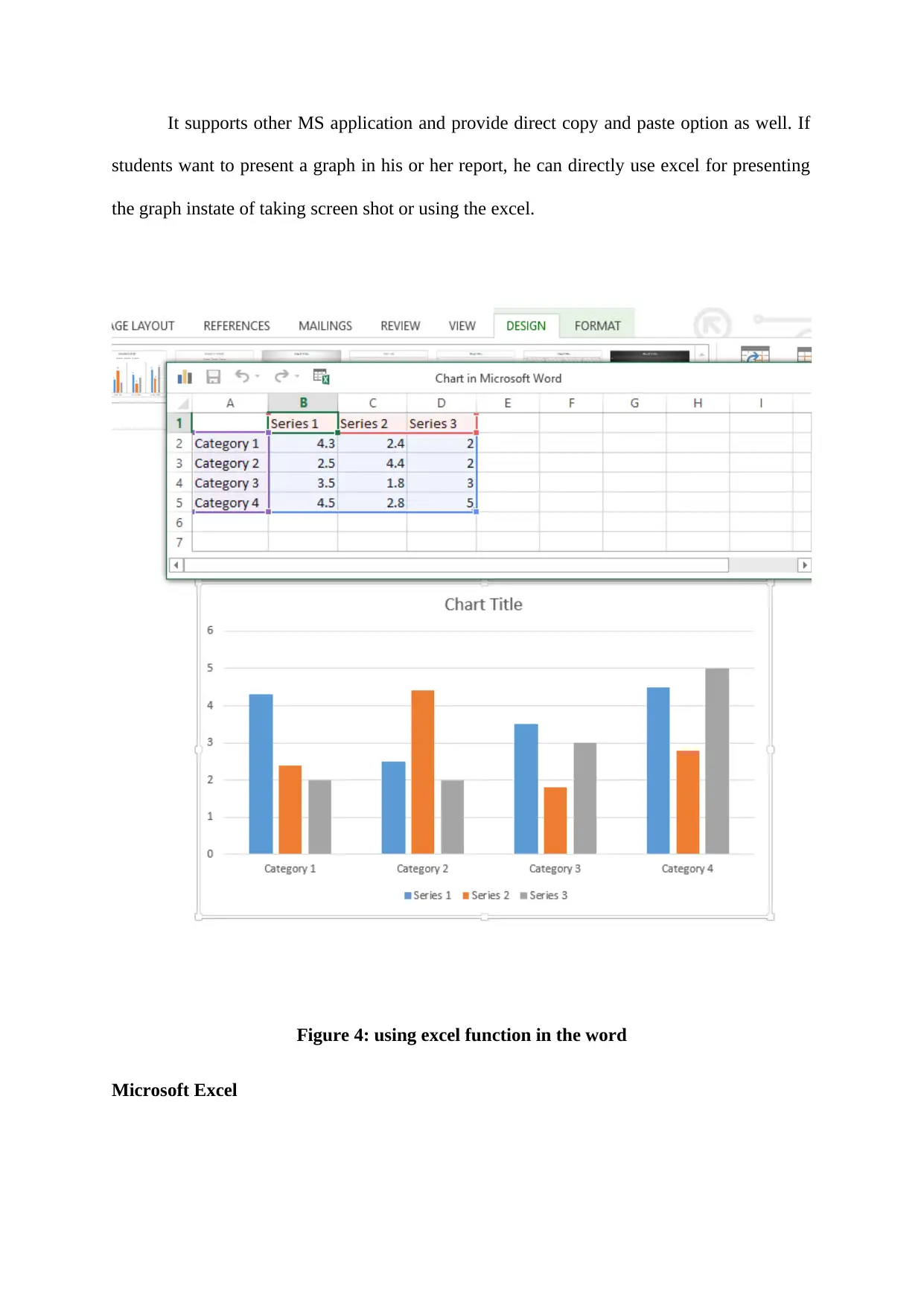
It supports other MS application and provide direct copy and paste option as well. If
students want to present a graph in his or her report, he can directly use excel for presenting
the graph instate of taking screen shot or using the excel.
Figure 4: using excel function in the word
Microsoft Excel
students want to present a graph in his or her report, he can directly use excel for presenting
the graph instate of taking screen shot or using the excel.
Figure 4: using excel function in the word
Microsoft Excel
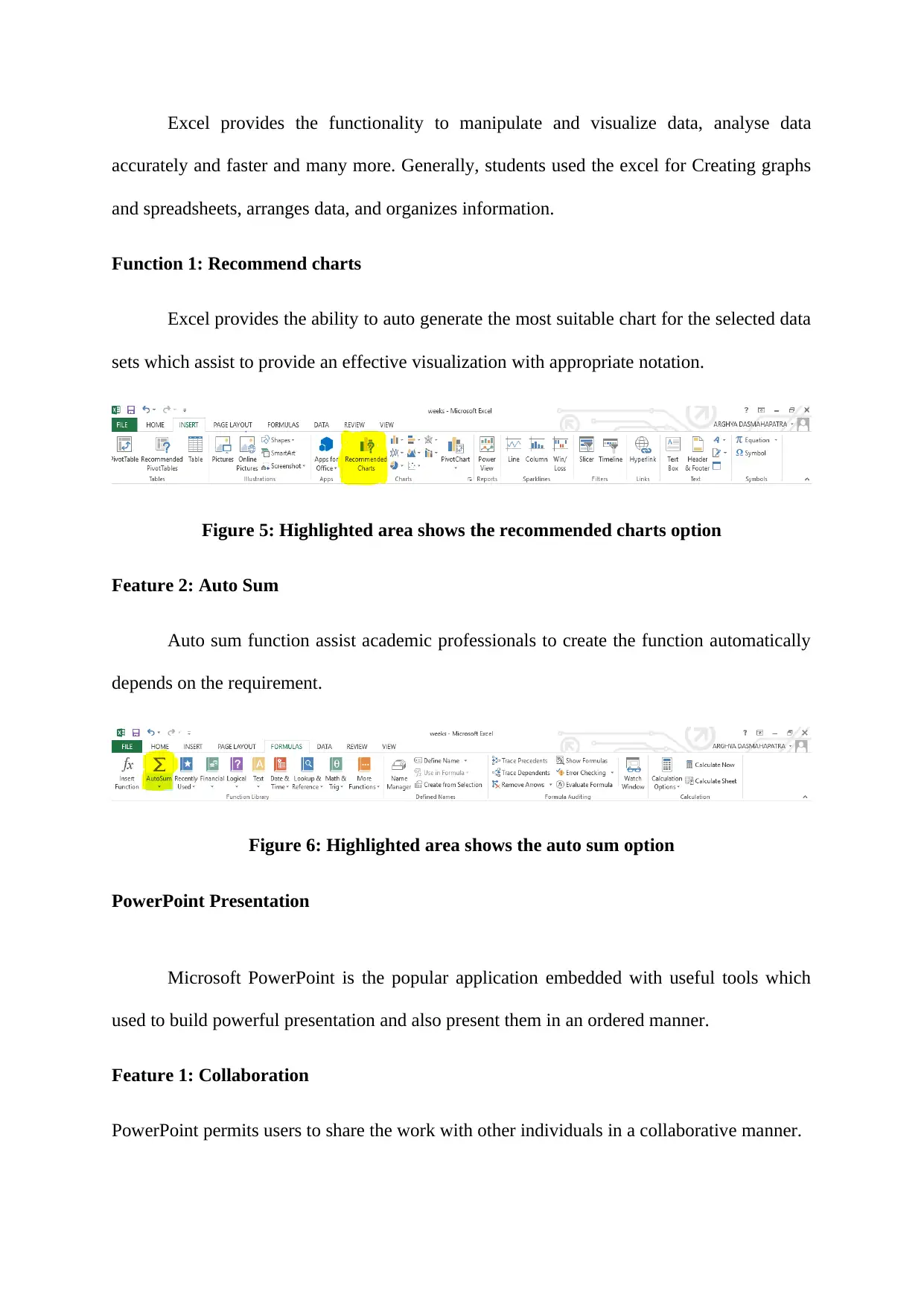
Excel provides the functionality to manipulate and visualize data, analyse data
accurately and faster and many more. Generally, students used the excel for Creating graphs
and spreadsheets, arranges data, and organizes information.
Function 1: Recommend charts
Excel provides the ability to auto generate the most suitable chart for the selected data
sets which assist to provide an effective visualization with appropriate notation.
Figure 5: Highlighted area shows the recommended charts option
Feature 2: Auto Sum
Auto sum function assist academic professionals to create the function automatically
depends on the requirement.
Figure 6: Highlighted area shows the auto sum option
PowerPoint Presentation
Microsoft PowerPoint is the popular application embedded with useful tools which
used to build powerful presentation and also present them in an ordered manner.
Feature 1: Collaboration
PowerPoint permits users to share the work with other individuals in a collaborative manner.
accurately and faster and many more. Generally, students used the excel for Creating graphs
and spreadsheets, arranges data, and organizes information.
Function 1: Recommend charts
Excel provides the ability to auto generate the most suitable chart for the selected data
sets which assist to provide an effective visualization with appropriate notation.
Figure 5: Highlighted area shows the recommended charts option
Feature 2: Auto Sum
Auto sum function assist academic professionals to create the function automatically
depends on the requirement.
Figure 6: Highlighted area shows the auto sum option
PowerPoint Presentation
Microsoft PowerPoint is the popular application embedded with useful tools which
used to build powerful presentation and also present them in an ordered manner.
Feature 1: Collaboration
PowerPoint permits users to share the work with other individuals in a collaborative manner.
⊘ This is a preview!⊘
Do you want full access?
Subscribe today to unlock all pages.

Trusted by 1+ million students worldwide
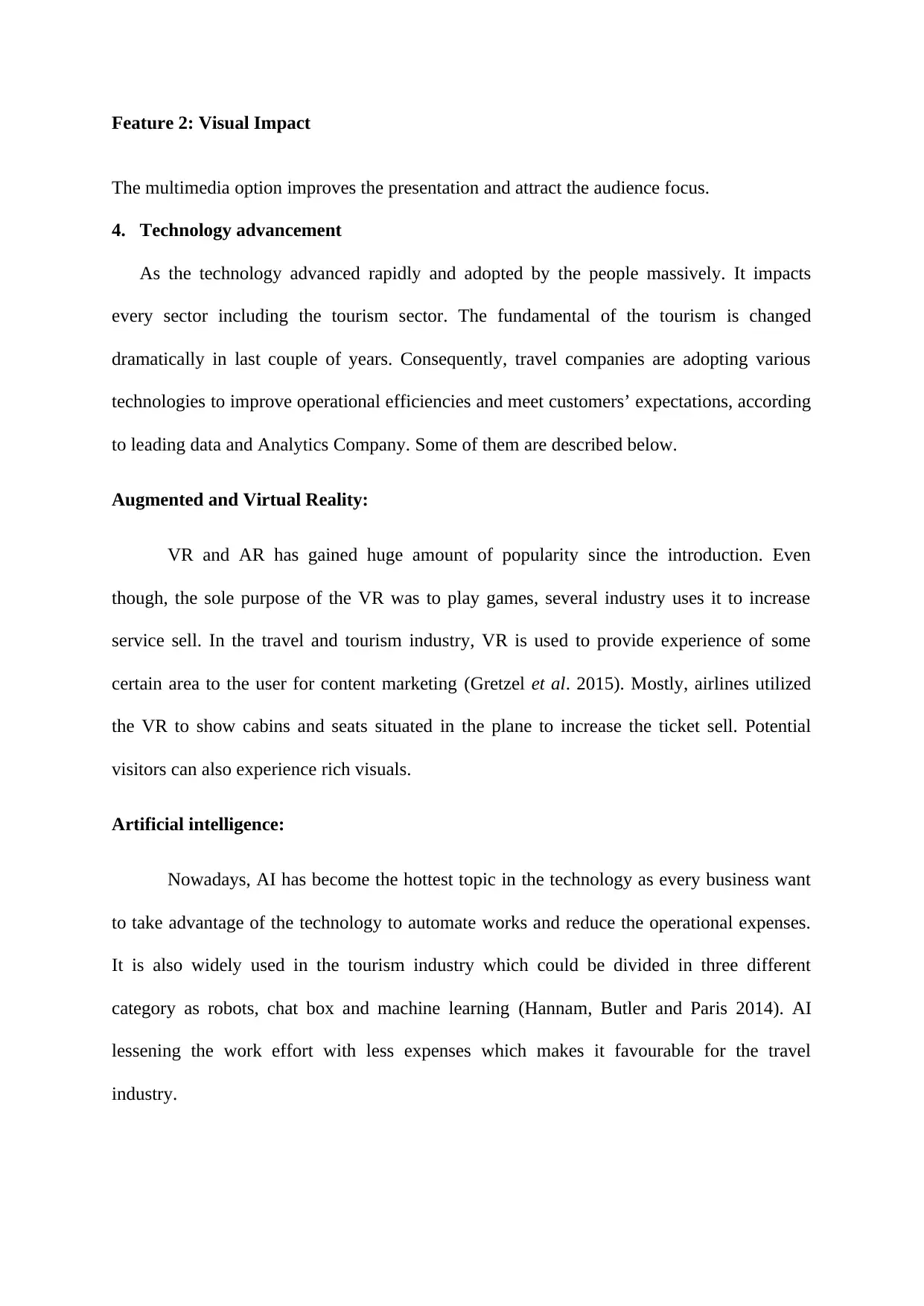
Feature 2: Visual Impact
The multimedia option improves the presentation and attract the audience focus.
4. Technology advancement
As the technology advanced rapidly and adopted by the people massively. It impacts
every sector including the tourism sector. The fundamental of the tourism is changed
dramatically in last couple of years. Consequently, travel companies are adopting various
technologies to improve operational efficiencies and meet customers’ expectations, according
to leading data and Analytics Company. Some of them are described below.
Augmented and Virtual Reality:
VR and AR has gained huge amount of popularity since the introduction. Even
though, the sole purpose of the VR was to play games, several industry uses it to increase
service sell. In the travel and tourism industry, VR is used to provide experience of some
certain area to the user for content marketing (Gretzel et al. 2015). Mostly, airlines utilized
the VR to show cabins and seats situated in the plane to increase the ticket sell. Potential
visitors can also experience rich visuals.
Artificial intelligence:
Nowadays, AI has become the hottest topic in the technology as every business want
to take advantage of the technology to automate works and reduce the operational expenses.
It is also widely used in the tourism industry which could be divided in three different
category as robots, chat box and machine learning (Hannam, Butler and Paris 2014). AI
lessening the work effort with less expenses which makes it favourable for the travel
industry.
The multimedia option improves the presentation and attract the audience focus.
4. Technology advancement
As the technology advanced rapidly and adopted by the people massively. It impacts
every sector including the tourism sector. The fundamental of the tourism is changed
dramatically in last couple of years. Consequently, travel companies are adopting various
technologies to improve operational efficiencies and meet customers’ expectations, according
to leading data and Analytics Company. Some of them are described below.
Augmented and Virtual Reality:
VR and AR has gained huge amount of popularity since the introduction. Even
though, the sole purpose of the VR was to play games, several industry uses it to increase
service sell. In the travel and tourism industry, VR is used to provide experience of some
certain area to the user for content marketing (Gretzel et al. 2015). Mostly, airlines utilized
the VR to show cabins and seats situated in the plane to increase the ticket sell. Potential
visitors can also experience rich visuals.
Artificial intelligence:
Nowadays, AI has become the hottest topic in the technology as every business want
to take advantage of the technology to automate works and reduce the operational expenses.
It is also widely used in the tourism industry which could be divided in three different
category as robots, chat box and machine learning (Hannam, Butler and Paris 2014). AI
lessening the work effort with less expenses which makes it favourable for the travel
industry.
Paraphrase This Document
Need a fresh take? Get an instant paraphrase of this document with our AI Paraphraser
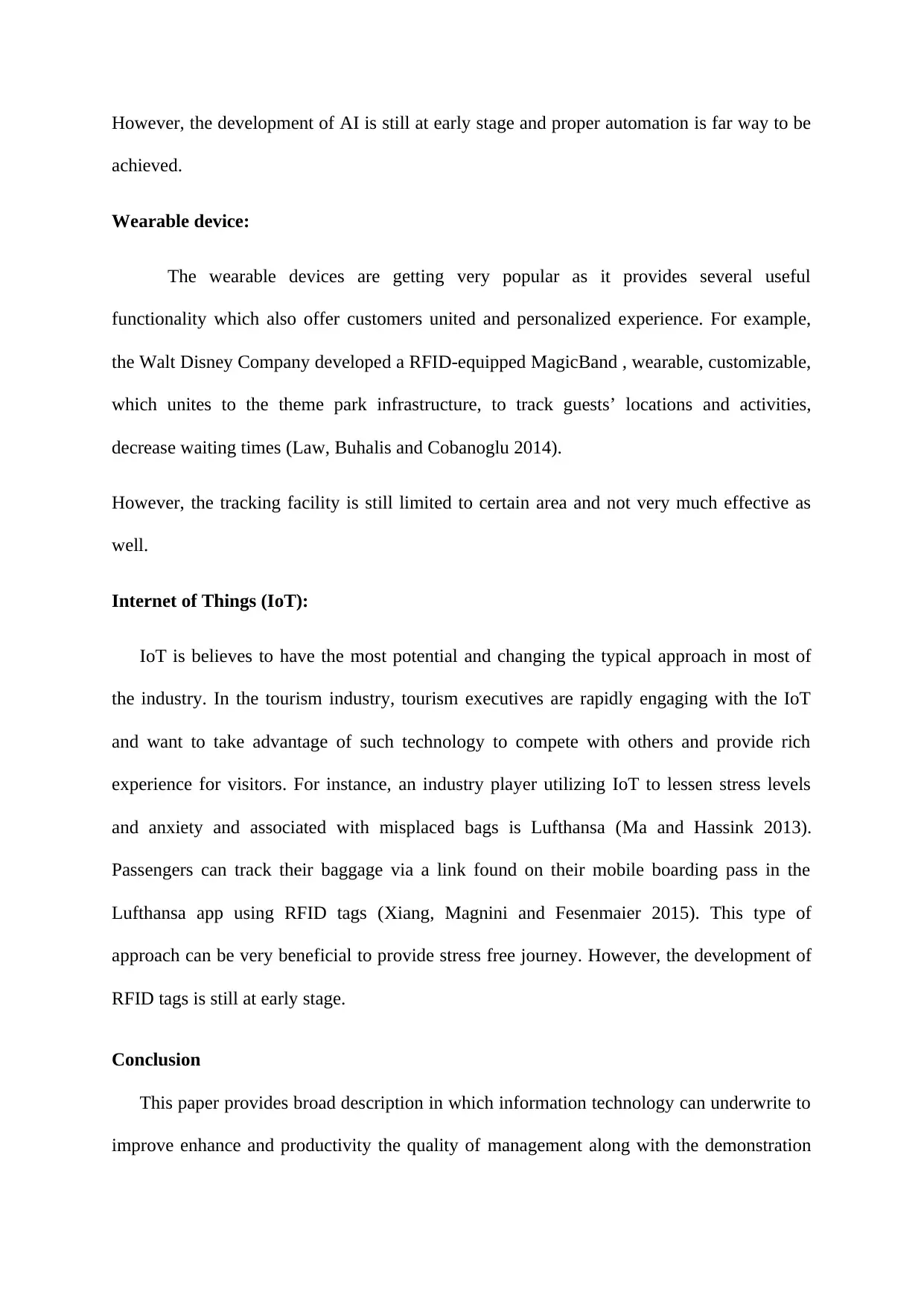
However, the development of AI is still at early stage and proper automation is far way to be
achieved.
Wearable device:
The wearable devices are getting very popular as it provides several useful
functionality which also offer customers united and personalized experience. For example,
the Walt Disney Company developed a RFID-equipped MagicBand , wearable, customizable,
which unites to the theme park infrastructure, to track guests’ locations and activities,
decrease waiting times (Law, Buhalis and Cobanoglu 2014).
However, the tracking facility is still limited to certain area and not very much effective as
well.
Internet of Things (IoT):
IoT is believes to have the most potential and changing the typical approach in most of
the industry. In the tourism industry, tourism executives are rapidly engaging with the IoT
and want to take advantage of such technology to compete with others and provide rich
experience for visitors. For instance, an industry player utilizing IoT to lessen stress levels
and anxiety and associated with misplaced bags is Lufthansa (Ma and Hassink 2013).
Passengers can track their baggage via a link found on their mobile boarding pass in the
Lufthansa app using RFID tags (Xiang, Magnini and Fesenmaier 2015). This type of
approach can be very beneficial to provide stress free journey. However, the development of
RFID tags is still at early stage.
Conclusion
This paper provides broad description in which information technology can underwrite to
improve enhance and productivity the quality of management along with the demonstration
achieved.
Wearable device:
The wearable devices are getting very popular as it provides several useful
functionality which also offer customers united and personalized experience. For example,
the Walt Disney Company developed a RFID-equipped MagicBand , wearable, customizable,
which unites to the theme park infrastructure, to track guests’ locations and activities,
decrease waiting times (Law, Buhalis and Cobanoglu 2014).
However, the tracking facility is still limited to certain area and not very much effective as
well.
Internet of Things (IoT):
IoT is believes to have the most potential and changing the typical approach in most of
the industry. In the tourism industry, tourism executives are rapidly engaging with the IoT
and want to take advantage of such technology to compete with others and provide rich
experience for visitors. For instance, an industry player utilizing IoT to lessen stress levels
and anxiety and associated with misplaced bags is Lufthansa (Ma and Hassink 2013).
Passengers can track their baggage via a link found on their mobile boarding pass in the
Lufthansa app using RFID tags (Xiang, Magnini and Fesenmaier 2015). This type of
approach can be very beneficial to provide stress free journey. However, the development of
RFID tags is still at early stage.
Conclusion
This paper provides broad description in which information technology can underwrite to
improve enhance and productivity the quality of management along with the demonstration
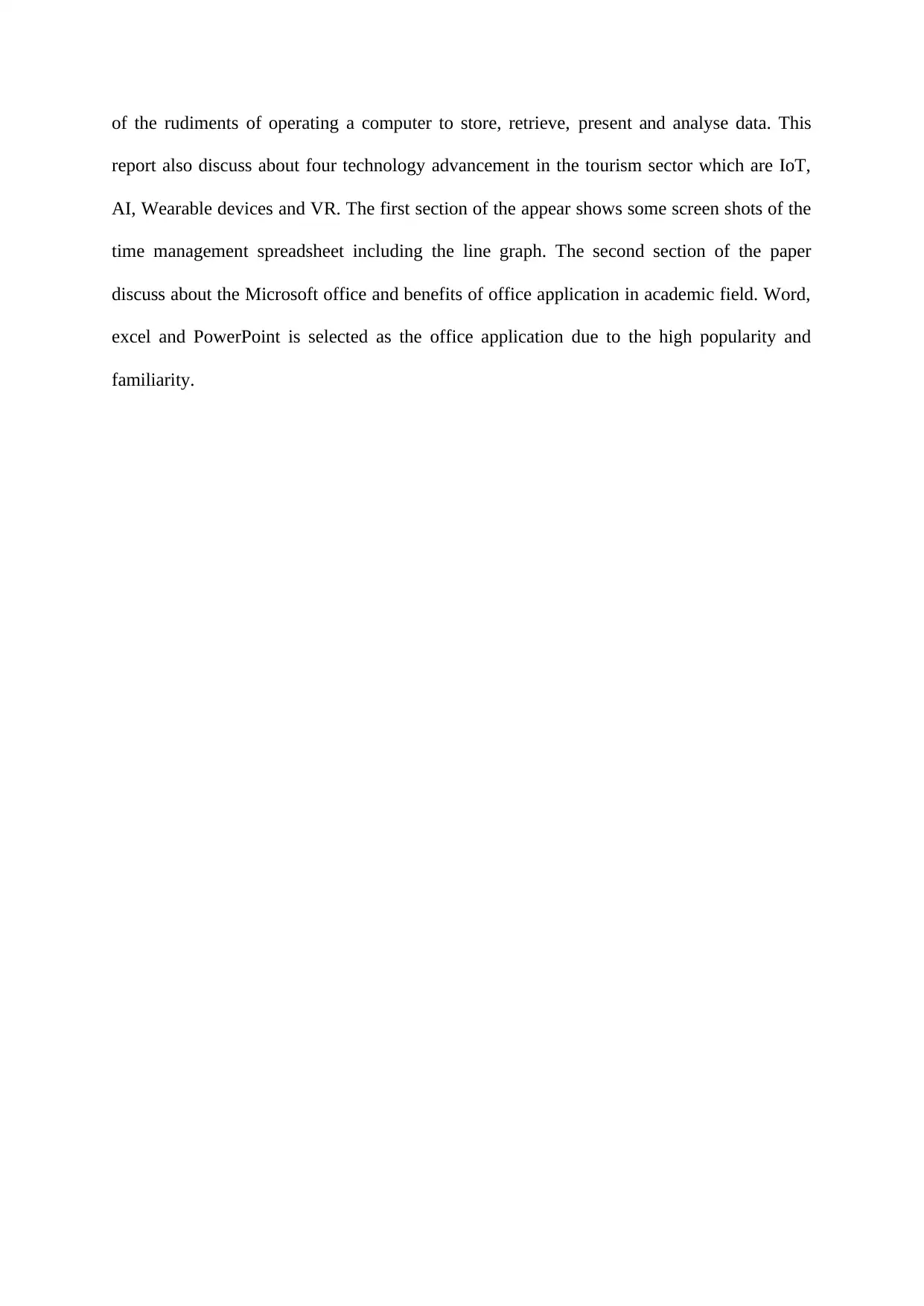
of the rudiments of operating a computer to store, retrieve, present and analyse data. This
report also discuss about four technology advancement in the tourism sector which are IoT,
AI, Wearable devices and VR. The first section of the appear shows some screen shots of the
time management spreadsheet including the line graph. The second section of the paper
discuss about the Microsoft office and benefits of office application in academic field. Word,
excel and PowerPoint is selected as the office application due to the high popularity and
familiarity.
report also discuss about four technology advancement in the tourism sector which are IoT,
AI, Wearable devices and VR. The first section of the appear shows some screen shots of the
time management spreadsheet including the line graph. The second section of the paper
discuss about the Microsoft office and benefits of office application in academic field. Word,
excel and PowerPoint is selected as the office application due to the high popularity and
familiarity.
⊘ This is a preview!⊘
Do you want full access?
Subscribe today to unlock all pages.

Trusted by 1+ million students worldwide
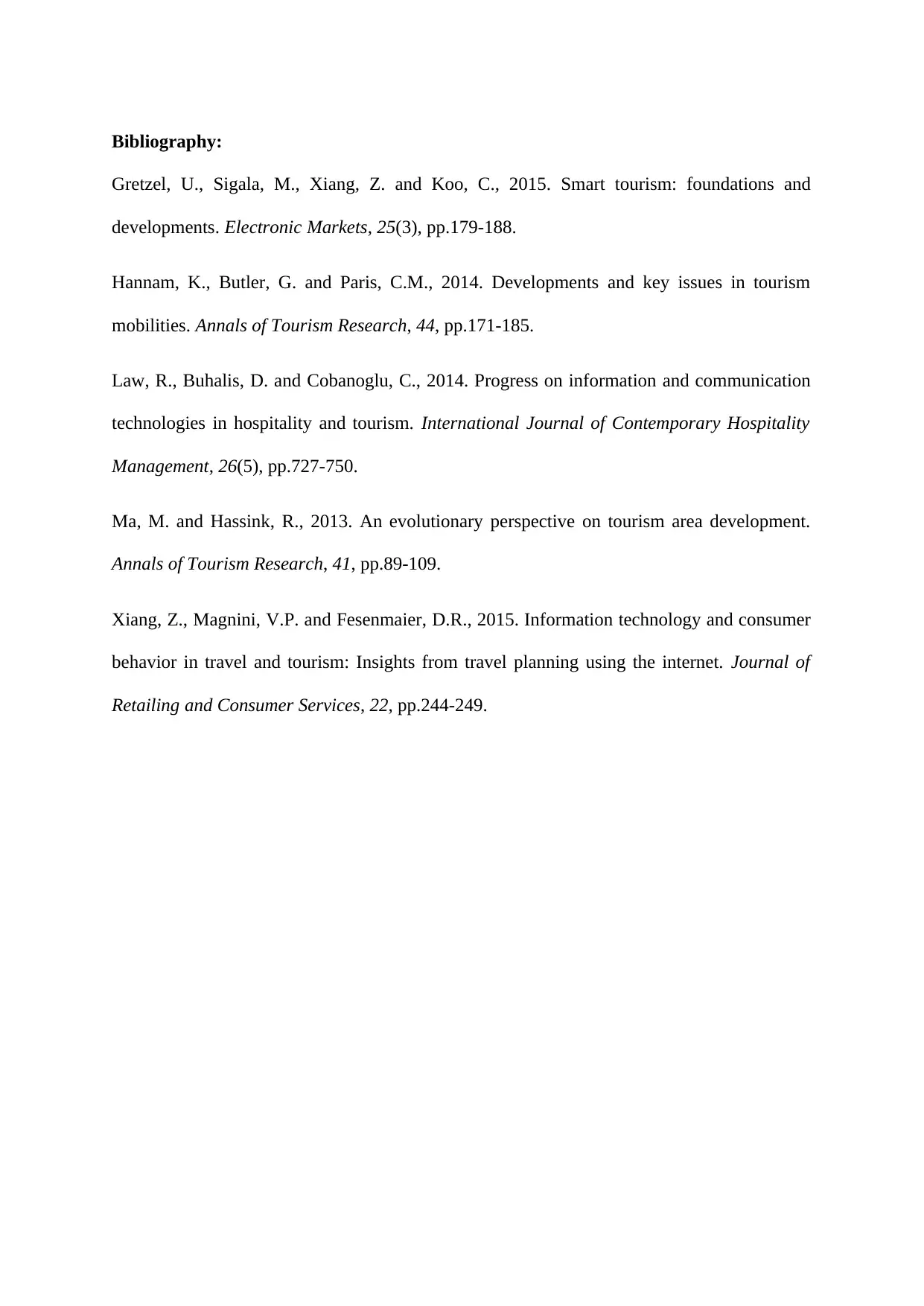
Bibliography:
Gretzel, U., Sigala, M., Xiang, Z. and Koo, C., 2015. Smart tourism: foundations and
developments. Electronic Markets, 25(3), pp.179-188.
Hannam, K., Butler, G. and Paris, C.M., 2014. Developments and key issues in tourism
mobilities. Annals of Tourism Research, 44, pp.171-185.
Law, R., Buhalis, D. and Cobanoglu, C., 2014. Progress on information and communication
technologies in hospitality and tourism. International Journal of Contemporary Hospitality
Management, 26(5), pp.727-750.
Ma, M. and Hassink, R., 2013. An evolutionary perspective on tourism area development.
Annals of Tourism Research, 41, pp.89-109.
Xiang, Z., Magnini, V.P. and Fesenmaier, D.R., 2015. Information technology and consumer
behavior in travel and tourism: Insights from travel planning using the internet. Journal of
Retailing and Consumer Services, 22, pp.244-249.
Gretzel, U., Sigala, M., Xiang, Z. and Koo, C., 2015. Smart tourism: foundations and
developments. Electronic Markets, 25(3), pp.179-188.
Hannam, K., Butler, G. and Paris, C.M., 2014. Developments and key issues in tourism
mobilities. Annals of Tourism Research, 44, pp.171-185.
Law, R., Buhalis, D. and Cobanoglu, C., 2014. Progress on information and communication
technologies in hospitality and tourism. International Journal of Contemporary Hospitality
Management, 26(5), pp.727-750.
Ma, M. and Hassink, R., 2013. An evolutionary perspective on tourism area development.
Annals of Tourism Research, 41, pp.89-109.
Xiang, Z., Magnini, V.P. and Fesenmaier, D.R., 2015. Information technology and consumer
behavior in travel and tourism: Insights from travel planning using the internet. Journal of
Retailing and Consumer Services, 22, pp.244-249.
1 out of 10
Related Documents
Your All-in-One AI-Powered Toolkit for Academic Success.
+13062052269
info@desklib.com
Available 24*7 on WhatsApp / Email
![[object Object]](/_next/static/media/star-bottom.7253800d.svg)
Unlock your academic potential
Copyright © 2020–2025 A2Z Services. All Rights Reserved. Developed and managed by ZUCOL.




